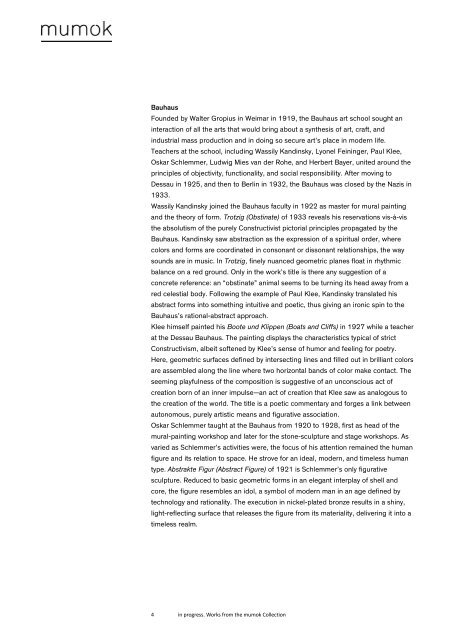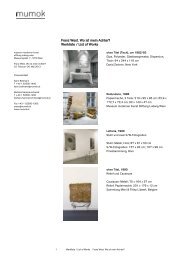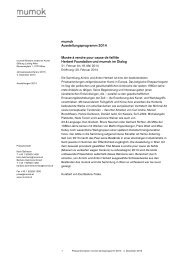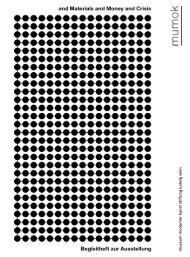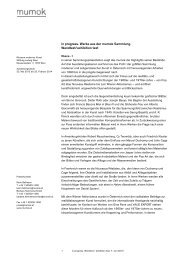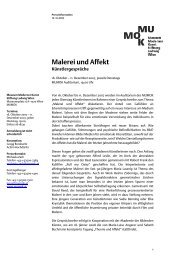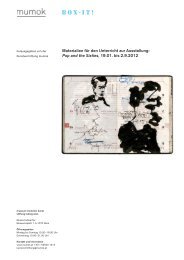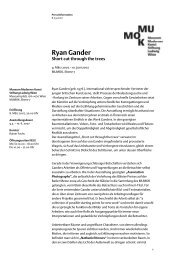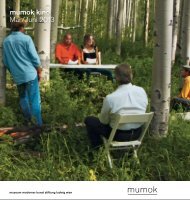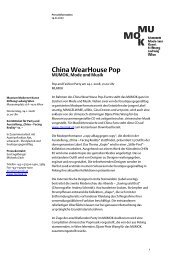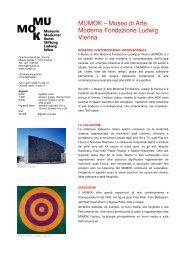Detailed information about the exhibition (212 KB) - Mumok
Detailed information about the exhibition (212 KB) - Mumok
Detailed information about the exhibition (212 KB) - Mumok
Create successful ePaper yourself
Turn your PDF publications into a flip-book with our unique Google optimized e-Paper software.
Bauhaus<br />
Founded by Walter Gropius in Weimar in 1919, <strong>the</strong> Bauhaus art school sought an<br />
interaction of all <strong>the</strong> arts that would bring <strong>about</strong> a syn<strong>the</strong>sis of art, craft, and<br />
industrial mass production and in doing so secure art’s place in modern life.<br />
Teachers at <strong>the</strong> school, including Wassily Kandinsky, Lyonel Feininger, Paul Klee,<br />
Oskar Schlemmer, Ludwig Mies van der Rohe, and Herbert Bayer, united around <strong>the</strong><br />
principles of objectivity, functionality, and social responsibility. After moving to<br />
Dessau in 1925, and <strong>the</strong>n to Berlin in 1932, <strong>the</strong> Bauhaus was closed by <strong>the</strong> Nazis in<br />
1933.<br />
Wassily Kandinsky joined <strong>the</strong> Bauhaus faculty in 1922 as master for mural painting<br />
and <strong>the</strong> <strong>the</strong>ory of form. Trotzig (Obstinate) of 1933 reveals his reservations vis-à-vis<br />
<strong>the</strong> absolutism of <strong>the</strong> purely Constructivist pictorial principles propagated by <strong>the</strong><br />
Bauhaus. Kandinsky saw abstraction as <strong>the</strong> expression of a spiritual order, where<br />
colors and forms are coordinated in consonant or dissonant relationships, <strong>the</strong> way<br />
sounds are in music. In Trotzig, finely nuanced geometric planes float in rhythmic<br />
balance on a red ground. Only in <strong>the</strong> work’s title is <strong>the</strong>re any suggestion of a<br />
concrete reference: an “obstinate” animal seems to be turning its head away from a<br />
red celestial body. Following <strong>the</strong> example of Paul Klee, Kandinsky translated his<br />
abstract forms into something intuitive and poetic, thus giving an ironic spin to <strong>the</strong><br />
Bauhaus’s rational-abstract approach.<br />
Klee himself painted his Boote und Klippen (Boats and Cliffs) in 1927 while a teacher<br />
at <strong>the</strong> Dessau Bauhaus. The painting displays <strong>the</strong> characteristics typical of strict<br />
Constructivism, albeit softened by Klee’s sense of humor and feeling for poetry.<br />
Here, geometric surfaces defined by intersecting lines and filled out in brilliant colors<br />
are assembled along <strong>the</strong> line where two horizontal bands of color make contact. The<br />
seeming playfulness of <strong>the</strong> composition is suggestive of an unconscious act of<br />
creation born of an inner impulse—an act of creation that Klee saw as analogous to<br />
<strong>the</strong> creation of <strong>the</strong> world. The title is a poetic commentary and forges a link between<br />
autonomous, purely artistic means and figurative association.<br />
Oskar Schlemmer taught at <strong>the</strong> Bauhaus from 1920 to 1928, first as head of <strong>the</strong><br />
mural-painting workshop and later for <strong>the</strong> stone-sculpture and stage workshops. As<br />
varied as Schlemmer’s activities were, <strong>the</strong> focus of his attention remained <strong>the</strong> human<br />
figure and its relation to space. He strove for an ideal, modern, and timeless human<br />
type. Abstrakte Figur (Abstract Figure) of 1921 is Schlemmer’s only figurative<br />
sculpture. Reduced to basic geometric forms in an elegant interplay of shell and<br />
core, <strong>the</strong> figure resembles an idol, a symbol of modern man in an age defined by<br />
technology and rationality. The execution in nickel-plated bronze results in a shiny,<br />
light-reflecting surface that releases <strong>the</strong> figure from its materiality, delivering it into a<br />
timeless realm.<br />
4 in progress. Works from <strong>the</strong> mumok Collection


